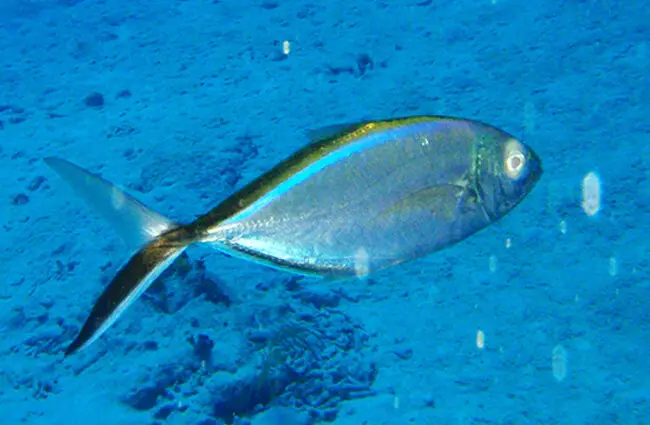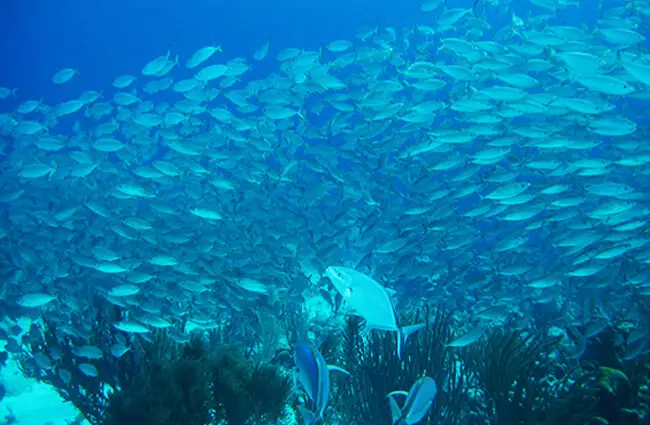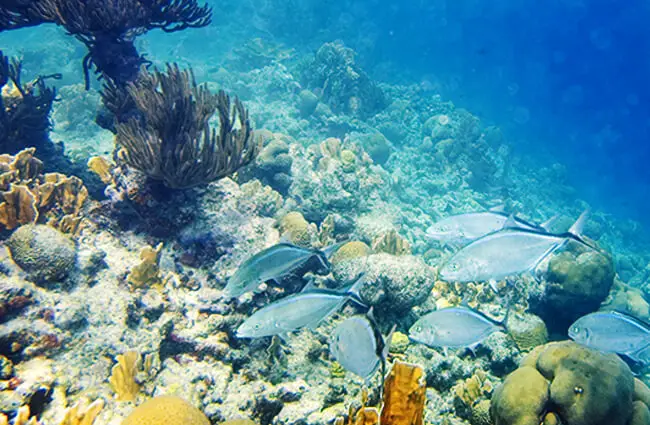Beneath the sun-drenched surface of the tropical Atlantic, a flash of silver and electric blue darts through the coral labyrinth. This is the Bar Jack, a true marvel of the marine world, known for its striking appearance, agile movements, and fascinating behaviors. Far more than just another reef fish, the Bar Jack plays a vital role in its ecosystem, captivating observers with its intelligence and adaptability. From its shimmering scales to its intricate social dynamics, this species offers a window into the vibrant life of our oceans.

Unveiling the Bar Jack: Basic Biology
The Bar Jack, scientifically known as Caranx ruber, belongs to the Carangidae family, a group commonly referred to as jacks or trevallies. These fish are renowned for their streamlined bodies, powerful tails, and predatory prowess. The Bar Jack itself is easily identifiable by its distinctive markings and sleek physique.
Physical Characteristics
Adult Bar Jacks typically reach lengths of about 1 to 2 feet (30 to 60 cm), though some individuals can grow larger, occasionally exceeding 2.5 feet (75 cm). Their bodies are elongated and compressed laterally, giving them a thin, disc-like profile from the front. The most striking feature is a prominent dark bar or stripe that runs horizontally along the upper flank, from the snout to the caudal fin. Below this dark stripe, a brilliant iridescent blue or blue-green stripe often shimmers, especially when the fish is active or excited. The rest of the body is typically silvery, with a white or pale underside. Their fins are often dusky or yellowish, adding to their subtle beauty.
Classification and Relatives
As members of the Carangidae family, Bar Jacks are related to other well-known species like the Crevalle Jack, Amberjack, and Permit. This family is characterized by fast-swimming, often schooling, predatory fish found in tropical and subtropical waters worldwide. Their shared evolutionary history points to adaptations for speed, agility, and efficient hunting in open water and reef environments.

Habitat and Distribution: Where to Find These Ocean Dancers
For animal lovers and aspiring zoologists eager to observe Bar Jacks in their natural environment, understanding their preferred habitat is key. These captivating fish are residents of the western Atlantic Ocean, with a range extending from the coast of New Jersey in the United States, south through Bermuda, the Bahamas, the Caribbean Sea, and down to the coast of Brazil. They are particularly abundant around the Florida Keys and throughout the Caribbean.
Preferred Environments
Bar Jacks are primarily associated with clear, shallow coastal waters. Their ideal homes include:
- Coral Reefs: They frequently patrol the edges and channels of coral reefs, using the complex structures for shelter and as hunting grounds.
- Sandy Flats: Often found over sandy bottoms adjacent to reefs, where they forage for invertebrates.
- Seagrass Beds: Juveniles and sometimes adults will utilize seagrass beds for protection and food.
- Mangrove Areas: Younger Bar Jacks may also inhabit mangrove estuaries, which provide crucial nursery habitats.
- Wrecks and Artificial Reefs: These structures also attract Bar Jacks, offering shelter and aggregation points.
They typically inhabit depths ranging from just a few feet down to about 60 feet (18 meters), though they can occasionally be found deeper. Their preference for clear water makes them a favorite subject for snorkelers and divers.
Finding Bar Jacks in the Wild
If you are an animal lover hoping to spot a Bar Jack, your best bet is to visit the clear, warm waters of the Caribbean or the Florida Keys. Look for them:
- Swimming in small schools near reef edges.
- Patrolling sandy patches adjacent to coral formations.
- Following larger fish or rays, a behavior known as “shadowing” or “riding.”
A good pair of snorkeling gear or scuba diving equipment will offer the best views. Remember to observe from a respectful distance to avoid disturbing their natural behavior.

Diet and Feeding Behavior: Agile Predators of the Reef
The Bar Jack is an opportunistic and efficient predator, playing a crucial role in the food web of its marine habitat. Their diet is varied, reflecting their adaptability and the abundance of prey in their environment.
What’s on the Menu?
Their diet primarily consists of:
- Small Fish: Silversides, sardines, and other small schooling fish are a staple.
- Invertebrates: Crabs, shrimp, and other crustaceans are frequently consumed.
- Squid and Octopi: Smaller cephalopods also form part of their diet.
Hunting Strategies
Bar Jacks employ several clever hunting strategies:
- Schooling Predation: While often seen individually or in small groups, Bar Jacks can form larger schools to herd and ambush smaller fish. This coordinated effort increases their hunting success.
- “Riding” Behavior: One of the most fascinating behaviors is their tendency to “ride” or “shadow” larger marine animals, such as stingrays, nurse sharks, or even other large fish. As these larger animals disturb the sandy bottom while foraging, they flush out small invertebrates and fish, which the Bar Jack then swiftly snatches up. This symbiotic relationship provides an easy meal for the Bar Jack and demonstrates a remarkable level of interspecies interaction.
- Ambush Predation: They will also lie in wait near reef structures, darting out with incredible speed to capture unsuspecting prey.
This diverse feeding strategy highlights their intelligence and adaptability, making them formidable hunters in their ecosystem.

Mating and Reproduction: The Cycle of Life
The reproductive cycle of the Bar Jack is typical of many pelagic spawners, characterized by external fertilization and a reliance on ocean currents for dispersal.
Spawning Process
Bar Jacks are broadcast spawners, meaning they release their eggs and sperm directly into the water column. Spawning typically occurs in open water, often in aggregations, to maximize the chances of fertilization. The exact timing can vary, but it often peaks during warmer months, though some spawning may occur year-round in tropical regions.
- Egg Release: Females release numerous small, buoyant eggs.
- Fertilization: Males simultaneously release sperm, fertilizing the eggs in the water.
- No Parental Care: Like many marine fish, Bar Jacks exhibit no parental care after spawning. The eggs and subsequent larvae are left to drift with the ocean currents.
Larval and Juvenile Development
The fertilized eggs hatch into tiny, planktonic larvae. These larvae spend their early lives drifting in the open ocean, feeding on microscopic organisms. As they grow, they undergo metamorphosis, developing into juvenile fish. These juveniles then migrate towards shallower, protected coastal habitats such as seagrass beds and mangrove estuaries, which offer abundant food and shelter from larger predators. This critical nursery habitat ensures the survival of the next generation of Bar Jacks.

Social Behavior and Ecosystem Contribution
Bar Jacks are highly social fish, and their interactions with other species and their environment are integral to the health of the marine ecosystem.
Schooling Dynamics
While often seen individually, Bar Jacks frequently form schools, especially when foraging or during spawning. These schools can range from small groups of a dozen individuals to larger aggregations. Schooling offers several advantages:
- Predator Defense: A large group can confuse predators, making it harder for them to target a single individual.
- Enhanced Foraging: Coordinated hunting efforts can be more effective in capturing prey.
- Reproductive Success: Aggregations during spawning increase the likelihood of successful fertilization.
Ecosystem Role and Interspecies Interactions
Bar Jacks are vital components of the reef ecosystem:
- Predator: By preying on small fish and invertebrates, they help regulate populations of these species, preventing overpopulation and maintaining ecological balance.
- Prey: Juveniles and adults are, in turn, prey for larger predatory fish like barracudas, sharks, and groupers, transferring energy up the food chain.
- Symbiotic Relationships: Their “riding” behavior with larger animals like stingrays is a classic example of commensalism, where the Bar Jack benefits without harming the host. This behavior also helps to aerate and disturb the sediment, potentially benefiting benthic organisms.
- Indicator Species: A healthy population of Bar Jacks can indicate a thriving reef ecosystem with a good supply of prey and suitable habitat.

The Evolutionary Journey of the Bar Jack
Understanding the evolutionary history of the Bar Jack provides deeper insight into its adaptations and its place within the vast tree of life. As a member of the Carangidae family, its lineage traces back millions of years, evolving alongside the dynamic changes of the world’s oceans.
Origins within Carangidae
The Carangidae family is a diverse group of ray-finned fish that emerged relatively recently in evolutionary terms, likely during the Eocene epoch (around 56 to 34 million years ago). These fish rapidly diversified, adapting to various marine environments. The Bar Jack, like its relatives, developed a fusiform (spindle-shaped) body plan, highly efficient for fast swimming and pursuit predation in open water and reef environments. Key adaptations include:
- Streamlined Body: Reduces drag, allowing for bursts of speed.
- Forked Caudal Fin: Provides powerful propulsion.
- Laterally Compressed Body: Enhances maneuverability in complex reef structures.
- Acute Vision: Essential for spotting prey and predators in clear waters.
Their evolutionary success is evident in their wide distribution and ecological importance across tropical and subtropical seas.

Interaction with Humans: From Fishing to Conservation
Bar Jacks interact with humans in several ways, primarily through recreational fishing and ecotourism. Understanding these interactions is crucial for both conservation and responsible engagement.
Recreational Fishing
Bar Jacks are a popular target for recreational anglers, particularly in the Caribbean and Florida. They are known for their strong fighting spirit when hooked, making them an exciting catch. They are often caught using light tackle, live bait, or artificial lures. While edible, their flesh is not as highly prized as some other game fish, and they are sometimes released after capture.
Human Consumption and Ciguatera Risk
Bar Jacks are consumed in some regions, but like many reef fish, they can accumulate ciguatera toxins. Ciguatera is a foodborne illness caused by eating fish that have consumed certain dinoflagellates (microscopic algae) that produce toxins. The risk increases with the size and age of the fish, as toxins accumulate over time. Therefore, caution is advised when consuming larger Bar Jacks, especially from areas known for ciguatera outbreaks.
Conservation Status
Currently, the Bar Jack is listed as “Least Concern” by the IUCN (International Union for Conservation of Nature), indicating a stable population. However, like all reef-associated species, they face threats from habitat degradation (due to coral bleaching, pollution, and coastal development), overfishing in localized areas, and the impacts of climate change. Sustainable fishing practices and marine protected areas are vital for ensuring their long-term survival.
Cultural Significance
While not holding the same iconic status as some larger marine species, the Bar Jack is a recognizable and appreciated part of the marine fauna in regions where it is abundant. Its presence contributes to the vibrant underwater landscapes that draw tourists and support local economies through diving and snorkeling.
Bar Jacks in Captivity: A Zookeeper’s Guide
Caring for Bar Jacks in a captive environment, such as a public aquarium, requires specific knowledge and dedication to replicate their natural conditions as closely as possible. Zookeepers play a vital role in their welfare.
Habitat Requirements
To thrive, Bar Jacks need a spacious and well-designed exhibit:
- Tank Size: Due to their active nature and potential size, a very large tank is essential. A minimum of several thousand gallons is recommended for a small school, with larger tanks being preferable.
- Water Parameters:
- Temperature: Maintain tropical temperatures, typically between 75-82°F (24-28°C).
- Salinity: Stable marine salinity, around 1.023-1.025 specific gravity.
- pH: Stable pH between 8.1-8.4.
- Water Quality: Excellent filtration and regular water changes are paramount to maintain low nitrate and phosphate levels. Strong water flow is also beneficial to simulate their natural environment and provide exercise.
- Aquascaping: Provide a mix of open swimming space, rocky or coral structures for shelter and visual interest, and sandy areas. Ensure no sharp edges that could injure fast-moving fish.
Diet and Feeding in Captivity
A varied and nutritious diet is crucial:
- Primary Diet: High-quality frozen seafood such as silversides, krill, shrimp, and squid.
- Supplementation: Fortify food with vitamin supplements to ensure complete nutrition.
- Feeding Frequency: Juveniles may require multiple feedings per day, while adults can be fed once or twice daily.
- Enrichment: Offer food in ways that encourage natural hunting behaviors, such as scattering it or using feeding devices.
Social Needs and Compatibility
Bar Jacks are schooling fish and should ideally be kept in groups of three or more to reduce stress and encourage natural behaviors. They are generally compatible with other similarly sized, non-aggressive reef fish. Avoid housing them with very small fish they might prey upon or highly aggressive species that could stress them.
Tasks and Considerations for Zookeepers
- Daily Monitoring: Observe behavior, appetite, and physical condition for any signs of illness or stress.
- Water Parameter Checks: Regular testing to ensure optimal water quality.
- Tank Maintenance: Keep the exhibit clean, remove uneaten food, and maintain filtration systems.
- Enrichment: Provide environmental enrichment to prevent boredom and stimulate natural behaviors.
- Quarantine: New arrivals must undergo a strict quarantine period to prevent disease introduction.
What to Avoid
- Overcrowding: Leads to stress, aggression, and poor water quality.
- Inadequate Tank Size: Restricts natural swimming behavior and growth.
- Monotonous Diet: Can lead to nutritional deficiencies.
- Sudden Changes: Avoid abrupt changes in water parameters or tank mates, which can cause stress.
- Aggressive Tank Mates: Can lead to injury or chronic stress.
Encountering Bar Jacks in the Wild: A Hiker’s (or Diver’s) Guide
For those exploring coastal areas or snorkeling/diving in their habitat, encountering a Bar Jack can be a memorable experience. Knowing how to react ensures both your safety and the well-being of the fish.
What to Do
- Observe from a Distance: Bar Jacks are generally not aggressive towards humans. Maintain a respectful distance to avoid startling them or disrupting their natural behavior.
- Move Slowly and Quietly: Erratic movements or loud noises can scare fish away.
- Appreciate Their Beauty: Take the time to watch their graceful movements, observe their schooling patterns, and perhaps even witness their fascinating “riding” behavior with other marine animals.
- Stay in Designated Areas: If you are in a marine park or protected area, adhere to all rules and guidelines.
- Report Unusual Sightings: If you notice any signs of distress, injury, or unusual behavior in a Bar Jack or other marine life, report it to local wildlife authorities or park rangers.
What NOT to Do
- Do NOT Touch or Harass: Never attempt to touch, chase, or feed wild fish. This can stress them, alter their natural behaviors, and potentially expose you to harm (e.g., sharp fins) or toxins (like ciguatera if you were to handle one and then touch your mouth).
- Do NOT Remove Anything: Leave all marine life, including shells and coral fragments, in their natural environment.
- Do NOT Litter: Always pack out what you pack in. Marine debris is a significant threat to all ocean inhabitants.
- Do NOT Use Sunscreen with Harmful Chemicals: Opt for reef-safe sunscreens to protect coral reefs and the organisms that depend on them.
Your responsible actions contribute directly to the conservation of these beautiful creatures and their vital habitats.
A Huge List of Interesting Facts About Bar Jacks
The Bar Jack is full of surprises. Here are some fascinating tidbits that highlight their unique characteristics and behaviors:
- Speed Demons: Their torpedo-shaped bodies and powerful caudal fins make them incredibly fast swimmers, capable of rapid bursts to catch prey or escape predators.
- Color Changers: While their primary coloration is silvery with a dark bar, Bar Jacks can subtly adjust their iridescence and the intensity of their blue stripe, especially during excitement or stress.
- The “Riding” Phenomenon: Their commensal relationship with larger animals like stingrays is one of the most well-documented and intriguing interspecies interactions in the reef.
- Long-Lived for a Jack: Bar Jacks can live for over 10 years in the wild, a respectable lifespan for a medium-sized predatory fish.
- Keen Eyesight: They possess excellent vision, crucial for spotting small prey and navigating complex reef environments.
- Opportunistic Hunters: They are not picky eaters and will consume almost any small fish or invertebrate they can catch, making them highly adaptable.
- Schooling for Safety: Juveniles and adults often form schools, a classic anti-predator strategy that also aids in foraging.
- Reef Health Indicators: A healthy population of Bar Jacks often signifies a thriving and biodiverse reef ecosystem.
- Sport Fish Appeal: Despite their relatively small size compared to other jacks, their spirited fight on a fishing line makes them a favorite among light tackle anglers.
- Widespread Distribution: Their range spans a significant portion of the Western Atlantic, from temperate to tropical waters.
Conclusion: The Enduring Allure of the Bar Jack
From its shimmering scales to its intricate dance with other reef inhabitants, the Bar Jack stands as a testament to the beauty and complexity of marine life. This agile predator, with its distinctive markings and clever hunting strategies, is more than just a pretty face; it is a crucial thread in the vibrant tapestry of the Caribbean and Atlantic ecosystems. Whether observed by a curious diver, studied by an aspiring zoologist, or admired by an angler, the Bar Jack offers endless opportunities for discovery and appreciation. Protecting its habitats and understanding its role are vital steps in ensuring that future generations can continue to marvel at this remarkable ocean dancer.

![Red Angus Closeup of a beautiful Red Angus cowPhoto by: U.S. Department of Agriculture [pubic domain]https://creativecommons.org/licenses/by/2.0/](https://animals.net/wp-content/uploads/2020/03/Red-Angus-4-238x178.jpg)




![Red Angus Closeup of a beautiful Red Angus cowPhoto by: U.S. Department of Agriculture [pubic domain]https://creativecommons.org/licenses/by/2.0/](https://animals.net/wp-content/uploads/2020/03/Red-Angus-4-100x75.jpg)

